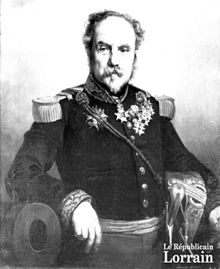Henri Joseph Paixhans
Henri Joseph Paixhans (born January 22, 1783 in Metz , † August 20, 1854 in Jouy-aux-Arches near Metz) was a French Général de division and engineer .
Paixhans joined the naval artillery after attending the École polytechnique in Paris . He made great contributions to the training of the hollow projectile fire of the large cannons and invented u. a. 1822 the bomb cannons , which were only completely displaced from 1871 by the rifled artillery.
Paixhans also developed the "Mortier monstre" ( Eng . "Monster mortar " ), which could fire 500 kg explosive charges and had devastating effects during the siege of Antwerp in 1832.
In addition, the French was considered the most outstanding naval theorist in his country and thus founded the Jeune École . From him came the thesis that a handful of modern, well-equipped units could take on an entire fleet if they acted aggressively . He indirectly incorporate those born of necessity tactics of the southern states in the American Civil War requires that sought refuge in the development of modern techniques.
But his basic strategic considerations were also important for warfare on land. The military theorist and lieutenant colonel Alexandre Jardot (1804-1891) took up Paixhans' basic idea of the advantage of the "strategy of the inner line" in his book "Railways as strategic lines" (1842) , in which the defender better uses his shorter supply lines due to the central arrangement can be used to fend off several opponents at the same time.
Paixhans died on August 20, 1854 with the rank of general on Jouy aux Arches near Metz.
Works
- Considérations sur l'artillerie des places etc. (Paris 1815)
- Nouvelle force maritime (Paris 1821)
- Force et faiblesse de la France (Paris 1830; German von Kausler, Stuttgart 1841)
- Constitution militaire de la France (Paris 1849)
literature
- Lawrence Sondhaus: Navies of Europe. 1815-2002. Longman, Edinburgh 2002, ISBN 0-582-50613-1 .
Individual evidence
- ↑ About the monster mortar used off Antwerp. In: Polytechnisches Journal . 48, 1833, p. 260.
- ^ Rolf Hobson: Maritimer Imperialismus: Seemachtideologie, Seestrategisches Thinking and the Tirpitzplan, 1875 to 1914. Oldenbourg Wissenschaftsverlag, Munich 2004, ISBN 3-486-56671-7 , p. 64.
- ↑ Klaus-Jürgen Bremm: From Chaussee to Rail: Military Strategy and Railways in Prussia 1833 to 1866. Oldenbourg Verlag, Munich 2005, ISBN 3-486-57590-2 , p. 83. Note: Jardot was the first to use the term “Strategy the inner line ” .
| personal data | |
|---|---|
| SURNAME | Paixhans, Henri Joseph |
| BRIEF DESCRIPTION | French general and engineer |
| DATE OF BIRTH | January 22, 1783 |
| PLACE OF BIRTH | Metz |
| DATE OF DEATH | August 20, 1854 |
| Place of death | Jouy-aux-Arches |



